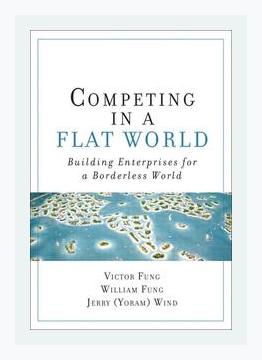Business StrategyBusiness Ecosystems
Title: Competing in a Flat World: Building Enterprises for a Borderless World
Authors: Victor K. Fung and William K. Fung
Publication Year: 2007
Category: Business Ecosystems
Summary
Introduction
In “Competing in a Flat World: Building Enterprises for a Borderless World,” Victor K. Fung and William K. Fung explore the dynamics of global supply chains and the strategies companies can adopt to thrive in this interconnected environment. Leveraging their experience from Li & Fung, a global trading company, the authors present insights into building agile enterprises with a borderless approach. The text delves into the concept of “flattening” in the business world, inspired by Thomas Friedman’s notion of the “flat world,” and offers practical strategies backed by real-life examples.
Major Points and Actions
-
Leveraging a Network-Based Organization
- Concept: The authors argue for a shift from traditional hierarchical organizations to network-based models that enable companies to be more flexible and responsive.
- Example: Li & Fung operates as a network orchestrator, managing a global web of suppliers, manufacturers, and logistics providers. This allows them to create tailored solutions for clients with speed and precision.
- Action: Restructure organizational workflows to become more network-oriented, partnering with external entities to optimize each part of the supply chain.
-
The Idea of Disaggregation
- Concept: Disaggregation involves breaking down the supply chain into distinct, manageable processes that can be outsourced to specialized providers.
- Example: Li & Fung disaggregates production tasks such as design, fabric procurement, and assembly, utilizing different suppliers across countries to enhance efficiency.
- Action: Identify core business processes that can be disaggregated and outsourced to experts in those fields, thereby focusing internal resources on competitive strengths.
-
Flexibility and Speed
- Concept: To compete in a flat world, businesses must be able to rapidly adapt to market changes and reduce time-to-market for new products.
- Example: Li & Fung’s ability to quickly respond to fashion trends by rapidly sourcing and producing garments ensures that their clients stay relevant in a fast-paced industry.
- Action: Develop a fast-response system within the organization that leverages real-time data and close relationships with suppliers and customers to react swiftly to market demands.
-
Building a Collaborative Ecosystem
- Concept: Establishing a collaborative ecosystem that involves all stakeholders in the supply chain, including suppliers, partners, and customers, is crucial for innovation and efficiency.
- Example: Li & Fung collaborates closely with retailers and suppliers to co-create products, aligning their ecosystem to respond to consumer needs effectively.
- Action: Foster a culture of collaboration through open communication channels and joint development projects with partners and suppliers.
-
Information Transparency and Technology Utilization
- Concept: Information technology and transparency across supply chain processes are essential for maintaining a competitive edge in a flat world.
- Example: Li & Fung employs advanced IT systems to track and share information within its network, ensuring all parties have up-to-date data for decision-making.
- Action: Invest in IT infrastructure that supports real-time data sharing and transparency, allowing all members of the supply chain to access critical information.
-
Creating Value Through Customization
- Concept: Offering customized solutions to meet specific client needs can set a company apart in a globalized market landscape.
- Example: Li & Fung’s tailored supply chain configurations cater to individual client requirements, helping them distinguish themselves from standardized offerings.
- Action: Develop capabilities to customize products and services to client specifications, ensuring that every solution is uniquely suited to their needs.
-
Risk Management
- Concept: In a flat world, risk management takes on new dimensions with global exposure to diverse market, financial, and geopolitical risks.
- Example: Li & Fung diversifies production across multiple countries to mitigate risks associated with political instability or natural disasters in any single location.
- Action: Implement a risk management strategy that includes geographic diversification and contingency planning to hedge against disruptions in the supply chain.
-
Resource Optimization
- Concept: Efficiently utilizing resources across the supply chain can lead to significant cost savings and enhanced competitive advantage.
- Example: By optimizing the use of materials and production locations, Li & Fung is able to reduce costs while maintaining high-quality standards.
- Action: Regularly assess and optimize resource allocation in the supply chain, seeking opportunities to reduce waste and improve efficiency.
-
Sustainability and Ethical Supply Chains
- Concept: Sustainable and ethical practices are becoming increasingly important for global enterprises to maintain their reputation and fulfill corporate social responsibility (CSR).
- Example: Li & Fung emphasizes adherence to social and environmental standards among its suppliers, ensuring sustainable and ethical production processes.
- Action: Implement and enforce CSR policies that promote sustainability and ethical practices throughout the supply chain, from sourcing to final delivery.
-
Talent Management and Leadership
- Concept: Attracting, retaining, and developing talent capable of navigating the complexities of a flat world is essential for organizational success.
- Example: Li & Fung invests in training programs that equip employees with the skills necessary to manage global operations and network orchestration.
- Action: Develop and implement comprehensive talent management programs that focus on building skills relevant to global supply chain management and collaborative leadership.
Conclusion
“Competing in a Flat World” provides a detailed roadmap for companies aiming to succeed in an interconnected and borderless business environment. By emphasizing network-based organization structures, flexibility, collaboration, information transparency, risk management, customization, resource optimization, sustainability, and talent development, Victor and William Fung offer actionable strategies that can significantly enhance organizational agility and competitiveness. Through practical examples and insights from Li & Fung’s successful adaptation to the flat world, the book serves as a valuable guide for business leaders looking to innovate and lead in a globalized marketplace.
